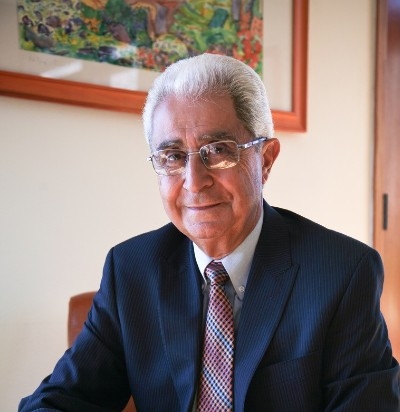In Memoriam: Haroutune Armenian, 1942–2025
Haroutune Armenian, MPH ’72, DrPH ’74, Professor Emeritus in the Department of Epidemiology passed away July 15, 2025.
Harout received his medical training from the American University of Beirut in Lebanon before embarking on a distinguished career in public health that began with an MPH and DrPH from the Johns Hopkins Bloomberg School of Public Health. He once described this journey as, "unusual for medical students at the time. Having no recent role model, it was sort of an adventure."

Dr. Haroutune Armenian
And what an adventure it was. He joined the faculty of the American University of Beirut in 1974 and became a member of our community in the Department of Epidemiology in 1986. During his tenure at the School of Public Health, Harout held several vital roles. He served as the Deputy Chair of Epidemiology from 1988 to 1993, Director of the MPH program from 1989 to 1996 and Interim Chair of the Department of Epidemiology from 1993 to 1994. However, his contributions to public health extend far beyond his roles at the school. Harout was the founding Dean and President of the American University of Armenia and played a pivotal role in the success of its School of Public Health. Additionally, he served as Dean of the Faculty of Health Sciences at the American University of Beirut, Associate Dean of Academic Programs at the UCLA Fielding School of Public Health, and Chair of the Department of Epidemiology, Public Health and Environment at King Saud University, Riyadh. Harout also served as editor-in-chief of Epidemiologic Reviews from 1989 to 2004.
His career in public health is characterized by a clear responsiveness to the pressing needs of the world around him. He was among the earliest to apply epidemiologic methods to study the health effects of war and natural disasters. Notably, he studied the impacts of the civil war in Lebanon during the 1970s and 1980s and also examined the long-term impacts of the 1988 earthquake in Northern Armenia that killed 25,000 people. His work included establishment of the first cohort of earthquake survivors followed for more than 25 years.
Throughout his career, Harout received numerous accolades in recognition of his remarkable contributions to education and service, including the Presidential Medal of the Order of the Cedars from the Republic of Lebanon and the Movses Khorenatsi Presidential Medal of Service and Accomplishment from the Republic of Armenia.
Friends and colleagues at Johns Hopkins remember Harout as someone who was "deep and thoughtful as well as urbane and sophisticated" (Dean Emeritus Michael J. Klag, MD, MPH ‘87), and "constantly offering a reminder that epidemiology was about people and making them healthier" (Jonathan M. Samet, MD, MS, Past Chair 1994–2008). Many were the recipients of his famous watercolors, one of which is included on the cover of the 6th edition of Gordis’ Epidemiology.
He will also be remembered as a tireless educator. He was the recipient of the Golden Apple award, the Advising Teaching and Mentoring Award (on two occasions) and the Ernest Lyman Stebbins Medal. But, for those of us who were students when Harout was on faculty, what we will remember most is how he was always the first to ask a usually feared but definitely thought-provoking question in our Friday departmental seminars. His breadth of knowledge and sophisticated insight have without a doubt influenced the way generations of epidemiologists ask questions and solve problems. In this commentary in the American Journal of Epidemiology, he reminded us that we "need to accept the fact that epidemiology has as much of a social role as a scientific one. Public health action, problem solving and a sense of mission are what brings many students to epidemiology. A problem-solving, action-oriented epidemiology is consistent with that sense of mission."
In honoring Harout, we celebrate not just a remarkable epidemiologist, educator and artist, but we honor someone who continually inspired us to dig deeper, ask tougher questions, and remember the foundational principles and responsibility of our discipline. His spirit will undoubtedly live on, motivating future generations to approach their work in epidemiology and public health with the same passion and curiosity he exemplified. We extend our deepest condolences to his wife Sona and his family.
